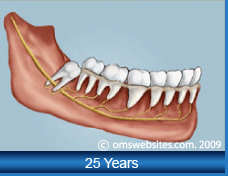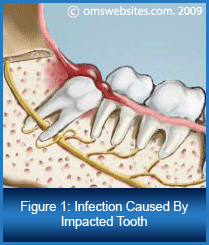 |
What are Wisdom Teeth?
The last molars to erupt in the back of your mouth are commonly known as Wisdom Teeth (Maxillary and Mandibular Third Molars). Normally a person will develop four wisdom teeth, but some people may have more or less.
|
| |
|
When and Why Should My Wisdom Teeth Be Removed?
A tooth becomes impacted because there is a lack of space in the dental arch, causing the tooth to grow on an angle towards the other molars and their roots.
This impaction can cause pain, lead to infection, or cause other pathologic conditions (See Figure 1).
The wisdom tooth may also crowd or damage the adjacent molar and its roots (See Figure 2), or damage the jaw bone and its nerves.
When the wisdom tooth is growing toward adjacent teeth, it can trap plaque and debris making your teeth more vulnerable to decay.
Wisdom teeth will likely cause problems as the patient ages. Approximately 85% of wisdom teeth will need to be removed. Early removal of wisdom teeth is recommended before the wisdom teeth begin to cause problems in your mouth and to avoid more complicated procedures in the future.
What Does Removing My Wisdom Teeth Require?
A wisdom tooth that is underneath the gums and pushed into the jawbone will require an incision into the gums and removal of the portion of bone that lies over the tooth. In this case, the tooth will be extracted in smaller portions to minimize the amount of bone that is removed.
Wisdom teeth can be removed using local anesthesia or some form of sedation. The anesthesia options will be discussed with you to determine what type of anesthesia is best for your needs.
What Does Recovery Involve?
After your wisdom teeth are removed you may experience some swelling and mild discomfort, which are normal symptoms and are part of the healing process. |
| |
|



 Members of the American Association of Oral and Maxillofacial Surgeons
Members of the American Association of Oral and Maxillofacial Surgeons Diplomates of the American Board
of Oral and Maxillofacial Surgery
Diplomates of the American Board
of Oral and Maxillofacial Surgery 












